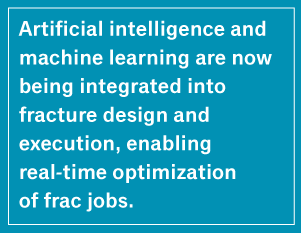
Fracturing And Refracturing Benefit From Diverse Array Of Technological Advances
By Jeremy Viscomi
The 2025 Society of Petroleum Engineers (SPE) Hydraulic Fracturing Technology Conference and Exhibition, held from Feb. 4–6 in The Woodlands, Tx., once again served as a premier gathering for industry professionals seeking to advance the science and practice of hydraulic fracturing. For upstream oil and gas operators, several sessions stood out as particularly valuable, offering fresh perspectives and case studies on field development strategies and technological advancements that have the potential to enhance efficiency, reduce costs and maximize recovery.
Subsurface Dynamics presented one of the more compelling sessions at this year’s conference in collaboration with the University of Calgary. Titled “New Hybrid Workflow for Field Development Planning and Execution: Early-Time Fracs vs. Long-Term Production,” the session introduced a workflow to improve field development strategies in unconventional reservoirs.
Traditionally, completion design has relied on separate evaluations of early-time frac performance and long-term production trends, often leading to inefficiencies in asset development. This hybrid workflow integrates flowback analysis (FBA) with long-term production data to offer a more comprehensive understanding of reservoir behavior, allowing for more precise well spacing, optimized fracture designs and improved economic outcomes.
Incorporating new correlations and asset maps enables operators to make data-driven decisions regarding completion parameters. The methodology leverages effective stress analysis, fracture surface area quantification, and permeability modeling to predict long-term performance. This represents a significant step forward in refining field development planning, as it moves beyond traditional trial-and-error approaches and embraces predictive analytics to improve overall asset performance. The key takeaway from this session was clear: integrating early-time frac data with long-term production metrics enhances the ability to optimize completion strategies, ultimately leading to greater recovery and improved economics for unconventional plays.
Another session that garnered significant attention examined emerging technologies related to equipment, digitalization and materials science. Among the highlights was next-generation fracturing equipment designed to enhance pumping efficiency, reduce downtime and minimize environmental impact.
The session also covered the growing role of digital transformation in hydraulic fracturing. AI and machine learning are now being integrated into fracture design and execution, enabling real-time optimization of frac jobs. Advanced data analytics allows operators to monitor key parameters such as pressure, proppant concentration and fluid distribution, ensuring that fractures are created efficiently and effectively. The implementation of automation and remote monitoring technologies was another major discussion point, as these tools are helping to improve safety and reduce the number of personnel required on-site, lowering overall operational costs.
The session also dove into material advancements, including developments in proppant technology and fracturing fluids that are enhancing well productivity. One of the most promising innovations discussed was the use of self-suspending proppants, which improves proppant transport and placement efficiency. These proppants reduce the volume of fluid required, leading to lower water usage and reduced chemical consumption. Additionally, new high-performance friction reducers are improving fluid efficiency.
For operators, the implications of these technological advancements are profound. Adopting next-generation fracturing equipment can lead to cost savings and environmental benefits, while integrating AI and automation into frac designs ensures that operations are optimized in real time. Moreover, advancements in materials science continue to improve well performance and longevity.
A third session that proved invaluable to operators focused on refracturing. This session provided a detailed analysis of refracturing techniques, highlighting best practices, economic considerations and case studies showcasing successful implementations.
The discussion emphasized the importance of candidate selection in refracturing operations. Not all wells are suitable candidates for refracturing, and proper diagnostics are essential in determining whether a well has the potential for production improvement. Diagnostic tools–such as fiber optic sensing, distributed acoustic sensing (DAS) and pressure transient analysis–are playing a crucial role in identifying underperforming wells that can benefit from refracturing. These technologies provide a clearer picture of fracture geometry, fluid distribution and production efficiency, helping operators make informed decisions about which wells to target.
The session also covered various refracturing methods, including the use of diverters to temporarily seal off existing fractures and redirect treatment to under-stimulated areas of the reservoir. Advances in diverter technology have significantly improved the success rates of refracturing operations, enabling more effective re-stimulation of depleted wells. Additionally, the session highlighted the economic benefits of refracturing, noting that in many cases, it offers a cost-effective alternative to drilling new wells.

JEREMY VISCOMI is a strategic marketing expert for the oil and gas industry. Among his many roles, he serves as the Mid-Continent regional lead for the Petroleum Technology Transfer Council, providing independent operators with access to emerging technology aimed at reducing risk and growing profits.
For other great articles about exploration, drilling, completions and production, subscribe to The American Oil & Gas Reporter and bookmark www.aogr.com.
















